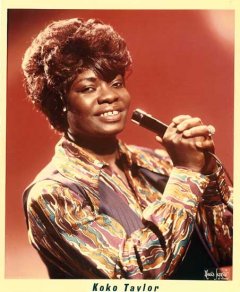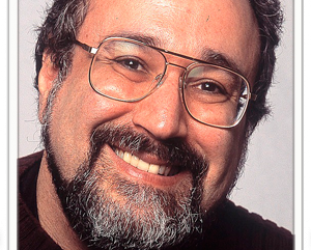Graham Reid | | 5 min read

Koko Taylor, the self-styled Queen of
the Blues, lets out a hoarse barking laugh and roars, “Yes, I'm
feelin' fine, thank God, and everybody is doing nicely.
“I've been back at work about six
weeks now and it feels good. I got bored staying at home. After 25
years out there doin' it you can get bored easily at home. I needed a
rest, but not like that,” she hoots.
It was 1988 and the Grammy
Award-winning blues wailer was referring to the car accident in
February of that year in which she broke several ribs and a
collarbone, and which had hospitalised two of her band members. But
she was back on the road, doing what she always did – taking her
throaty and often sexually earthy blues to anywhere that people would
listen.
Since her 1966 hit Wang Dang Doodle,
written by Willie Dixon, Taylor had been a major figure on the
traveling blues circuit throughout Europe and the States and has been
the visible face of the Chicago scene.
In '72 she'd formed her own band, the
Blues Machine which had an open-door policy on membership, and
recorded for the then-newly launched Alligator label from 1974.
Her albums were always good sellers by
blues standards and in the Eighties she began to gain considerable
recognition. She won the WC Handy Award seven years in a row, had six
Grammy nominations and her Queen of the Blues album in ’85 was
voted Best Blues Album by retailers and college radio jocks in the
States.
Not bad for a girl from Memphis brought
up on church music.
“I was singing gospel in a little
Baptist church in Memphis before I went to Chicago,” she told me in
'88. “I always sang the blues for my own enjoyment and it was only
after we came to Chicago I started recording and doing it for a
career.
“I was 18 when my husband and I went
to Chicago. I started singing in local clubs and just sitting in with
people like Howlin’ Wolf and Muddy Waters. It was 1964 when I
started trying to get into re-
cording,"
 She admits to some surprise when she
first went to Chicago, not the music “but there was just so much
going on."
She admits to some surprise when she
first went to Chicago, not the music “but there was just so much
going on."
“The clubs were very different then -
they were black clubs on the South Side with all black audiences.
Today the blues is on the North Side and it’s a white audience.”
That audience shift has been going on
for some 20 years now but Taylor can offer no explanation to why it
has happened. Like most blues artists she is confused about it,
disappointed blacks have abandoned "their music” but quite
happy to play for white audiences.
“I guess black people don’t get a
lot of blues on the radio these days, but maybe they're tired of it
anyway, They’ve been hearing it all their lives and now want to
hear something new and different.
“Right now rap is the style – but
one time disco was in the style, and rock has been around for years.
“But when you stop and think about
it, the blues never dies."
Singing the blues kept Taylor in work,
however, but her audience wasn't in her home city.
“There’s plenty of work for local
entertainers but I wouldn't consider myself local. Most of my work is
out of town.
“The audience in Europe is fantastic
because Europeans don’t have a lot of blues clubs or musicians.
That means whoever comes through from the US, they all come out in a
big lump sum because if they miss that artist they may never get to
see them again."
Taylor’s favourite clubs in Chicago
were Kingston Mi Mines and Biddy Mulligan’s on the North Side, or
the Checkerboard Lounge, one of the few remaining blues clubs on the
South Side.
It was at these clubs she was playing
with her new Blues Machine of James Johnson (guitar), Eddie King
(guitar), Jerry Murphy (bass) and Frank Alexander (drums).
"No, there`s no sax or piano in
there, but I guarantee you won’t miss ’em," she laughs.
Taylor's material brought together a
lot of familiar blues standards and the occasional new song - in the
old style - which she wrote herself.
“It's not so difficult to write but I
don‘t have the time because I'm always thinking about the songs I'm
doing then, then I try to rest. I sure can't travel and write.
“But I've managed to come up with a
couple of tunes for each album. I sure didn't spend the time after my
accident writing new things.
“I was just thanking God for still
bein' alive and concentrating on getting well.”
And she was well again and aiming to
get back to her customary schedule of 150 to 200 performances a
year:"If I can hold up.“
 Taylor had been spotted by Willie Dixon
in 1962 and '65, Taylor signed to Chess Records. Her hit Wang Dang
Doodle had been written by Dixon and recorded by Howlin' Wolf five
years previous but her version went to four on the r'n'b charts in
'66. It sold over a million and she recorded many versions of it over
her career, most famously at the '67 American Folk Blues Festival
with harmonica player Little Walter and guitarist Hound Dog Taylor.
Taylor had been spotted by Willie Dixon
in 1962 and '65, Taylor signed to Chess Records. Her hit Wang Dang
Doodle had been written by Dixon and recorded by Howlin' Wolf five
years previous but her version went to four on the r'n'b charts in
'66. It sold over a million and she recorded many versions of it over
her career, most famously at the '67 American Folk Blues Festival
with harmonica player Little Walter and guitarist Hound Dog Taylor.
And although she never looked back as
far as touring and recording were concerned, it was her last major
chart success despite all those awards and nominations.
She continued to tour throughout the
Nineties and found some small success in the films Blues Brothers
2000 and Wild at Heart.
She opened a blues club on Division
Street in Chicago in '94, but it closed five years later.
In the last few years of her life
Taylor – who died in June '09 – was still playing more than 50
nights a year and she rarely didn't sing Wang Dang Doodle.
"You know, I always enjoy singing
that song because people want to hear it,” she told me. “And
whenever they want to hear it is always enjoyable to me.
“That’s what I'm out there for --
to make my fans happy. And that makes me happy.” _
Her final performance was at the Blues
Music Awards, just a fortnight before her death. She was 80.







post a comment